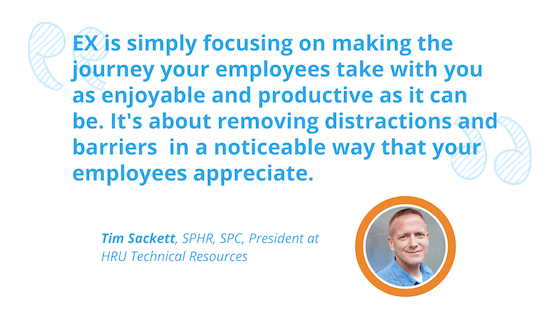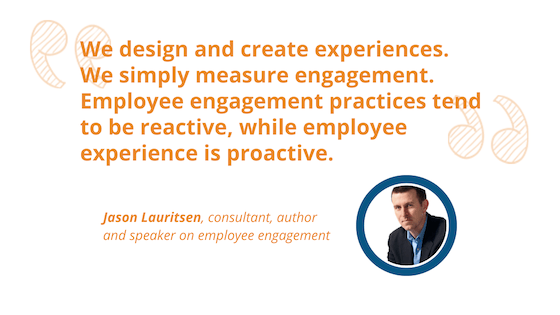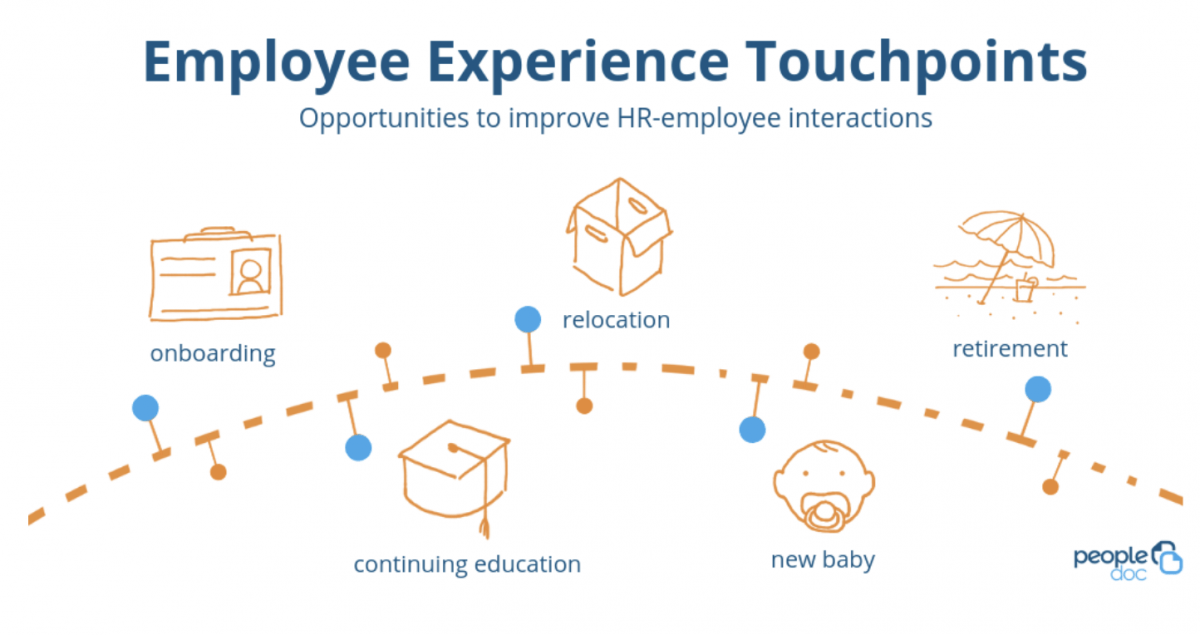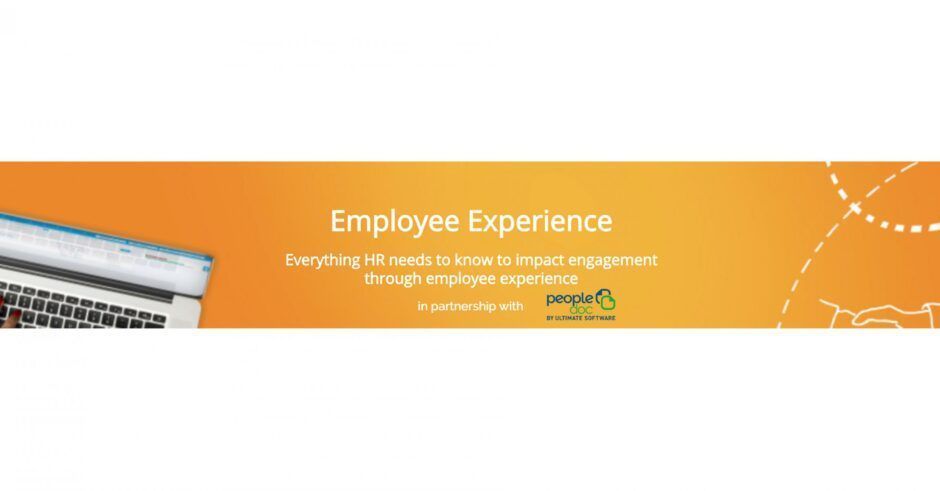Employee experience (or, “EX”) has become a bit of a buzzword lately, but it’s not just a new term for an old idea. There’s a critical link between EX and employee engagement, and companies with high engagement have seen a 4% increase in sales growth. A thoughtfully designed employee experience is swiftly becoming a necessity to compete in the war for talent. With AirBnB and Nike creating dedicated Chief Employee Experience Officer roles, it’s safe to say the concept of EX is here to stay. Understand exactly what EX is, how HR can influence it and the benefits in store for HR, the business and, of course, employees.
Employee experience, defined
What is employee experience (EX), exactly? According to Bersin by Deloitte, it’s “the sum total of all the touchpoints an employee has with his or her employer, from the time of being a candidate (active or passive) to becoming an alumnus or alumna.” The employee experience is often comprised of three main areas of work, according to the widely-accepted model attributable to Jacob Morgan. They include the (1) physical, (2) cultural and (3) technological workplace environments. If any of the three pillars of EX is weak, it can drastically affect how employees are engaged at work.
Across these three areas, the individual touchpoints an employee has with his or her company shape their overall experience and satisfaction level. These “moments of truth” can be intentionally shaped and designed, which is a concept that comes from other areas of business. User experience (UX) is a key ingredient in great software design, and customer experience (CX) plays a big role in how you feel about the things you buy and choose the companies you do business with.

The shift from employee engagement to employee experience
Employee engagement and employee experience are not interchangeable terms. EX influences engagement. If employees have a great experience at work because of the culture, technology or physical space, they are much more likely to be engaged. But, if they have a bad experience, even if they like the work they do, it becomes much harder for them to stay motivated and work hard. Of course, some individuals are less engaged by nature or due to external factors outside the company’s control, but focusing on EX can help mitigate the impact.
Because engagement is a byproduct of a positive EX, HR can be more effective if they focus their efforts on EX instead of engagement because it’s more actionable. HR can directly impact EX, whereas engagement isn’t as easy to control. Intentionally designing a positive EX can lead to sustained employee engagement (and therefore performance), which is much more impactful than simply reacting to employee grievances or issues revealed in a survey.

The link between employee experience and customer experience
Think about the technologies you use today and what makes them so great. Amazon provides personalized product recommendations. Google gives fast and accurate answers. Uber makes a painful process simple. All of these tools provide a great customer experience. Now, think about your own company customers. Would they put up with outdated, frustrating technology to buy something from you? Of course not. So why would it be any different for your employees?
The secret to employee experience is treating your employees like your best customer and giving them the same great digital experiences. In turn, they’re more likely to provide better customer service. Research has shown that engaged employees positively impact customer experience, and we know experience impacts engagement. Marriott International founder, J.W. Marriott, sums it up best: “Take care of associates and they’ll take care of your customers.”
The benefits of a positive employee experience
As we mentioned above, a focus on the employee experience can result in improved employee engagement. But there are several other benefits of a solid EX, including:
- Employer branding and the war for talent: As it is with products or services, if employees have a negative experience with your company, news can travel fast and damage your employer brand, ultimately hurting your talent acquisition efforts. This is especially important today as almost a quarter of employees switch jobs every 3-4 years. While some turnover is inevitable, a positive experience from candidacy all the way through to departure can ensure your company’s is perceived as a great place to work by both current employees and candidates.
- Retention: Considering the fact that average tenure is decreasing, a good EX can encourage workers to stay longer at your organization. Today’s workforce starts looking for their next role (usually at a new organization) after 18 months on the job, so improving the touchpoints for an employee’s first year and half is crucial. If employees are engaged, you have the chance to show them what mobility within your organization looks like so they can envision their next role with you, rather than look for a new position elsewhere.
- Productivity: Think about all the different interactions employees have with HR—completing onboarding paperwork, requesting paid time off, inquiring about the sick leave, or relocating to another office. If completing these tasks is time-consuming or confusing for employees, it takes time away from the work they were actually hired to do. When these processes are fast and easy experience for employees, they have more time in their day for their real job, resulting in a more productive workforce.
A framework for employee experience design
As with UX and CX, employee experience (EX) requires design thinking—a mindset that focuses on crafting a solution or desired outcome rather than simply getting rid of the perceived problem. This helps avoid putting in effort to fix the wrong problem or a problem that’s actually a symptom of something else. Below is a process for improving employee experience that’s rooted in design thinking:
Step 1: Determine your EX goals – The reality is HR is a cost center, not a profit center. To get executive buy-in for EX resources, it’s important to connect your EX goals to the business objectives. Build your business case by using metrics to show how a better EX can impact talent acquisition, cost savings, efficiency, etc. Remember that people success equals business success.
Step 2: Map the employee journey – To see where you can impact EX, start by mapping out the entire employee journey at your organization. Then, evaluate each engagement point. When employees need something from HR, what is the experience like today? What should it be like, ideally? Perform a gap analysis to identify what needs to change.
Step 3: Plan your approach – Once you know where you want to take your organization’s EX, think about what needs to happen in order to get there. Are there routine, manual processes that could be automated? Could it be easier for employees to access the information they need or request help from HR?
Step 4: Implement technology – Technology alone doesn’t ensure a great employee experience, but it’s a critical component to one. Technology can improve the EX by making things simpler and easier to accomplish. For example, a self-serve knowledge base makes finding HR policies as easy as a Google search. Technology can also facilitate lengthy processes, such as onboarding paperwork or a maternity leave request. And, it can help HR be more productive so they can focus on providing quality, engaging employee service, which equates to a better experience.
Step 5: Measure and evaluate – Look back to the goals you defined in Step 1 and make sure every engagement point in the journey gets tracked by some metric or KPI to indicate whether your EX is effective. For example, look at how long it takes an employee to complete a process. This can show whether your processes are really as easy and intuitive as you designed them to be.

What is the digital employee experience?
Today, employees expect their experiences at work to mirror their experience outside of work. They want to be able to search for information on their own, whenever and wherever they need it, like how they use Google. They want the information to be personalized, in the same way Netflix and Amazon makes tailored recommendations. And most of all, they want to be able to get things done quickly. In the workplace, processes and tasks are designed with long runways and multiple steps to help make them feel human or personal, but from an EX perspective, those processes are only time-consuming and cumbersome.
Designing for the digital employee experience (EX) is about closing the gap between how people get things done in their personal life and how they get things done in the workplace. If an employee doesn’t have to wait for information they need at home, why should they have to wait at work? Employees want to be able to take action on information once they have it, without having to go offline or log into another system.
Looking back at Jacob Morgan’s model, digital EX is part of the technological work environment. But even though digital experiences are only one component of EX, they can make their mark faster than the others. The physical takes time to build and make a lasting impact, and the cultural takes even longer. But digital experiences produce a point-in-time feeling that can leave a lasting impression—for better or for worse. Whether an employee has an easy, delightful experience requesting paternity leave—or a frustrating, confusing one—that one-off interaction for such a major life event can define his or her experience at your company.
The future of employee experience
To understand the future of the employee experience, just look at the technology in your own home. Today, instead of typing our question into Google, we ask Siri or Alexa. Virtual assistants may soon be how employees get help from HR. Though it can seem strange to talk to a device at first, these conversational experiences provide a much more natural, human experience.
But voice isn’t the only way HR transactions are becoming more conversational and human. Think about how we communicate through text. We have asynchronous (or real-time, if we choose) conversations within a single channel that threads together all exchanges with a certain person on a certain topic. In HR, providing employee service using this conversational style is part of a positive digital EX because it mimics the way employees communicate outside of the workplace.
So how can HR lead the future of employee experience? First, be sure to get comfortable with emerging technologies, such as AI and RPA—they’re not going away. Second, keep an eye out for any employee touchpoints that are complicated and messy. Technology is getting better and better at helping reduce manual, repetitive actions that bog down HR and employees. The result? HR is free to focus on strategies that support engaged and productive employees, who in turn can better focus on making an impact on the business and their career.
The Business Transformation Network have shared this article in partnership with People Doc.

